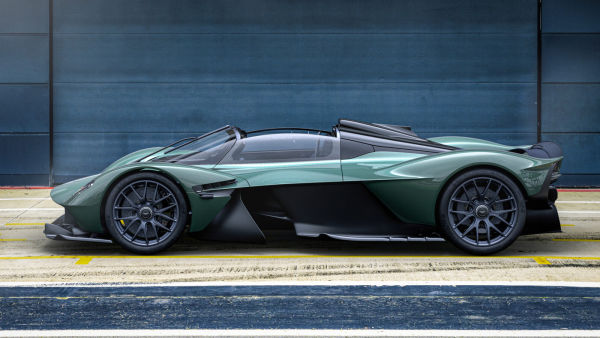In terms of high performance, there are two different paths to high horsepower ratings. One is known as “forced induction,” which uses a turbocharger or a supercharger to compress the engine’s fuel-air mixture. This process enables the engine to burn more fuel and more air during the combustion cycle, which produces more power.
Advertisement
The other path to power does not used forced induction, instead relying on the engine’s normal “breathing” abilities to develop maximum output. This typically involves engine design strategies that will allow the maximum amount of fuel and air to be processed at ambient atmospheric pressure, thereby raising the engine’s output. Engines of this type are known as naturally aspirated (NA) and the most powerful of these will be the focus of this article.
As these vehicles demonstrate, powerful naturally aspirated engines use sophisticated design techniques, high-tech materials, larger displacement, or a combination thereof to achieve high horsepower ratings. As another way to understand the incredibly high output levels of these amazing NA engines, a “power density” number is also included for each one. This is calculated by dividing horsepower output by engine displacement in liters, giving you the number of horsepower per liter of displacement. This is a way to objectively compare engines of different displacements and outputs. The higher the power density number, the more intrinsically powerful the engine is, regardless of its horsepower output. Here are seven powerful non-turbo cars with naturally aspirated engines, starting with the most powerful by horsepower rating and working our way down.
Advertisement
Porsche 911 GT3 RS: 518 horsepower
The Porsche 911 GT3 RS is a street-legal, track-ready performance car with a naturally aspirated high-output engine. For over 50 years (since 1972), the 911 RS models and their hard-edged performance credentials have become icons of the Porsche brand. The latest version, the 911 GT3 RS, packs a 4.0-Liter flat-six that produces an impressive 518 horsepower. With a power density of 129.5 horsepower per liter, the GT3 RS comes in ahead of the Corvette and the Ferrari listed here. Its redline is set at a screaming 9,000 rpm.
Advertisement
The advanced engine technologies that provide this spectacular power output include a motorsport-derived intake system and solid cam followers, along with new camshafts having modified profiles. Titanium connecting rods and forged pistons minimize the weight of the reciprocating parts within the engine, while a sport exhaust system made of lightweight stainless steel removes the spent exhaust gases.
Underbody air intakes on the Porsche 911 GT3 RS provide extra cooling for the seven-speed paddle-shifted PDK gearbox that has shorter gear ratios for faster acceleration. The electronically-regulated rear differential lock features variable torque distribution and drives the rear wheels.
Gordon Murray Automotive T.50: 661 horsepower
The Gordon Murray Automotive (GMA) T.50 is one man’s vision of the lightest, purest, most driver-oriented car ever made. The car’s namesake is Gordon Murray, famed Formula 1 car designer, whose McLaren F1 cars won world titles in 1988, 1989, and 1990. His next project was the McLaren F1 road car, the top-rated super car of the 1990s.
Advertisement
Those familiar with the McLaren F1 may see a resemblance to the GMA T.50. Both have the driver seated in the center forward position, flanked on each side by a lucky passenger. Both also have a naturally aspirated V12 engine. The T.50 is Gordon Murray’s attempt to fix the flaws he was unable to remedy in the McLaren F1, due to time restraints and limited resources.
The GMA T.50’s power unit is a 4.0-Liter V12, co-developed with engine builder Cosworth. The Cosworth/GMA V12 has a power output of 661 horsepower and wins the power density contest with 165.2 horsepower per liter, 11 hp/liter more than the Valkyrie. It does this through the use of a ram induction manifold, titanium connecting rods and valves, and an Inconel and titanium exhaust system. Redline is also the highest here at 12,100 rpm.
Advertisement
The T.50 sends its high-density power into a Xtrac six-speed manual transmission that is mounted transversely in its chassis. A limited-slip Salisbury differential then distributes it to the rear wheels. The T.50 is a brilliant take on a practical, daily-driver supercar. Unfortunately, all 100 production slots were taken within 48 hours of its announcement in August 2020.
Chevrolet Corvette Z06: 670 horsepower
The Chevrolet Corvette Z06 comes in as the leading U.S.-made car with a naturally-aspirated engine. The Corvette Z06’s engine is a 5.5-Liter, flat-plane LT6 V8 with an output of 670 horsepower. The LT6 V8 is a dual overhead cam (DOHC) design featuring a new aluminum block, stainless-steel exhaust headers, a six-stage dry-sump lubrication system, titanium intake valves, and sodium-filled exhaust valves.
Advertisement
Each engine is hand-assembled at the Corvette plant in Bowling Green, Kentucky, and bears a plaque signed by the technician who built it. The Z06’s NA engine has a redline of 8,500 rpm and a power density of 121.8 horsepower per liter.
The Corvette Z06 is a member of the Corvette’s eighth-generation, the first to use a mid-engine layout. The Z06’s engine channels its 670 horses through an eight-speed dual-clutch automatic transmission and then to the rear wheels. The Z06’s acceleration is even faster than its track-focused competitor, the Porsche GT3 RS, with the Corvette beating the Porsche to 60 mph by a tenth of a second and to 100 mph by seven-tenths.
Lamborghini Revuelto: 814 horsepower
The Lamborghini Revuelto is situated at the pinnacle of the Lamborghini lineup. It carries a naturally aspirated 6.5-Liter V12 with an output of 814 horsepower. That’s not all — the Revuelto’s V12 is part of a three-electric-motor hybrid system that cranks out a total of 1,001 horsepower, the highest total horsepower rating of any Lambo ever. Since the focus here is on the naturally aspirated, gasoline-powered part of the system, 814 is the number to discuss. This gives the Revuelto a power density of 125.2 horsepower per liter, which is very close to the Ferrari below.
Advertisement
The V12 engine in the Lamborghini Revuelto is all-new. It is turned 180 degrees from the typical Lamborghini V12 engine placement, placing its also-new eight-speed double-clutch transmission (DCT) behind it but mounted transversely in the chassis. This is the first time that a 12-cylinder Lamborghini has had a DCT transmission instead of the previous clunky ISR automated manual transmission (AMT). The V12 engine drives the rear wheels, but the Revuelto is actually an all-wheel drive car, thanks to the electric motors connected to the front wheels.
Ferrari Daytona SP3: 829 horsepower
The Ferrari Daytona SP3 is one of Ferrari’s “Icona” cars, which have been inspired by Ferrari’s past racing successes. The Daytona SP3 is an homage to the three Ferrari race cars that took the first three places at the 1967 International World Sports Car Championship’s first round at the 24 Hours of Daytona. As a modern, street-legal interpretation of the mid-engine sports prototype Ferrari 330 P3/4 that won that race, the Ferrari Daytona SP3 joined the two variations of the other car in the Icona series, the Ferrari Monza SP1 and SP2.
Advertisement
The Daytona SP3’s naturally aspirated engine is a 6.5-Liter V12 with a rating of 829 horsepower, making it the most powerful gasoline-powered engine built by Ferrari to date. It has a power density of 127.5 horsepower per liter, not quite as high as the top two cars, but still exceptional.
The SP3’s engine uses a wide variety of strategies to achieve its super-high output. Ferrari used the V12 engine in the 812 Competizione (known as F140HB) as the basis for the SP3, but it was moved from a front-engine to a mid-engine position. This allowed Ferrari engineers to optimize both the intake and the exhaust setups. Titanium connecting rods reduce inertia and weight, while a DLC (Diamond Like Carbon) treatment on the piston pins, sliding finger followers, and camshafts upgraded the SP3’s performance while reducing friction within the engine. The SP3’s 829 horses make their way through an F1 seven-speed dual-clutch gearbox before driving its rear wheels.
Advertisement
Pagani Huayra R Evo: 900 horsepower
The Pagani Huayra R Evo is an open-top, track-focused car developed for Pagani’s “Arte in Pista” program. This program is devoted to Pagani owners of track cars who participate in non-competitive events at FIA tracks around the world. Pagani track cars that have run in the “Arte in Pista” program include the Huayra R, the Zonda Revolucion, and the Zonda R.
Advertisement
The engine in the Huayra R Evo is a naturally aspirated 6.0-Liter V12 mounted lengthwise behind the driver. Known as the V12-R, its extremely high output of 900 horsepower translates to 150 horsepower per liter, just below that of the Aston Martin Valkyrie below.
The V12-R uses an upgraded intake manifold, new camshafts, and a revised exhaust system to generate its 900 horses. The Huayra R Evo’s redline is a very high 9,200 rpm. All of this power is fed to the rear wheels through a six-speed sequential gearbox with a sintered metal racing clutch.
Aston Martin Valkyrie: 1,000 horsepower
The top-rated car with a naturally aspirated engine is the Aston Martin Valkyrie, which is essentially a Formula 1 car that is road-legal. While the Valkyrie’s 6.5-Liter V12 engine is part of a gasoline-electric hybrid system, the gasoline engine alone produces a staggering 1,000 horsepower while spinning at an amazing 10,500 rpm. It also meets current emissions standards while doing it.
Advertisement
The Aston Martin Valkyrie’s powerplant was created by engine developer Cosworth. It achieves its spectacular output of 153.8 horsepower per liter with intake runners designed to provide plenty of air to the engine, combined with port fuel injection, which eliminates the need for a restrictive particulate filter in the exhaust system. Four catalytic converters instead of two also helps provide a less restrictive exhaust path. Using timing gears instead of a chain allows the engine to rev to 10,500 rpm without risk of engine damage (the redline is set to a screaming 11,110 rpm). This prodigious power is channeled through a seven-speed sequential transmission to the rear wheels.
Most of the engine’s internal components are machined from solid billets of various high-tech materials, including titanium connecting rods and Formula1-spec pistons. The finished engine weighs just 454 pounds (206 kilograms), comparable to what a Formula1 engine would weigh if it was scaled up to the Valkyrie’s 6.5-Liter size.
Advertisement








